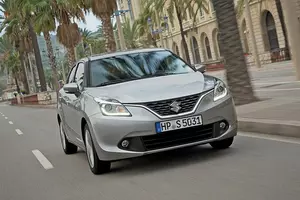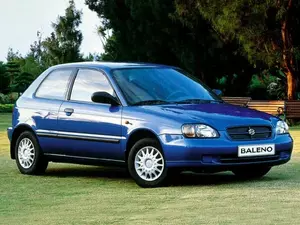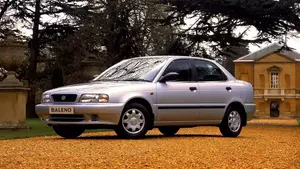
| Vehicle | Curb weight | Difference from world's smallest | Weight to power ratio | 0—60 mph acceleration ratio | Consumption ratio |
|---|---|---|---|---|---|
| 1.2 DUALJET |
990 kg / 2183 lbs |
565 kg (1246 lbs) heavier | 11 kg to 1 hp | 85 kg/s (187 lbs/s) |
248 kg/L (547 lbs/L) |
| 1.0 BOOSTERJET |
1010 kg / 2227 lbs |
585 kg (1290 lbs) heavier | 9 kg to 1 hp | 96 kg/s (212 lbs/s) |
206 kg/L (454 lbs/L) |
| Vehicle | 1.2 DUALJET |
|---|---|
| Curb weight |
990 kg / 2183 lbs |
| Difference from world's smallest | 565 kg (565 lbs) heavier |
| Weight to power ratio | 11 kg to 1 hp |
| 0—60 mph acceleration ratio | 85 kg/s (187 lbs/s) |
| Consumption ratio |
248 kg/L (547 lbs/L) |
| Vehicle | 1.0 BOOSTERJET |
| Curb weight |
1010 kg / 2227 lbs |
| Difference from world's smallest | 585 kg (585 lbs) heavier |
| Weight to power ratio | 9 kg to 1 hp |
| 0—60 mph acceleration ratio | 96 kg/s (212 lbs/s) |
| Consumption ratio |
206 kg/L (454 lbs/L) |

| Vehicle | Curb weight | Difference from world's smallest | Weight to power ratio | 0—60 mph acceleration ratio | Consumption ratio |
|---|---|---|---|---|---|
| 1.6 i 16V |
920 kg / 2029 lbs |
495 kg (1092 lbs) heavier | 9 kg to 1 hp | 87 kg/s (192 lbs/s) |
131 kg/L (289 lbs/L) |
| 1.3 i 16V |
890 kg / 1962 lbs |
465 kg (1025 lbs) heavier | 10 kg to 1 hp | 75 kg/s (165 lbs/s) | - |
| 1.8 GT |
935 kg / 2062 lbs |
510 kg (1125 lbs) heavier | 8 kg to 1 hp | - | - |
| 1.9 TD |
1030 kg / 2271 lbs |
605 kg (1334 lbs) heavier | 14 kg to 1 hp | - |
147 kg/L (324 lbs/L) |
| Vehicle | 1.6 i 16V |
|---|---|
| Curb weight |
920 kg / 2029 lbs |
| Difference from world's smallest | 495 kg (495 lbs) heavier |
| Weight to power ratio | 9 kg to 1 hp |
| 0—60 mph acceleration ratio | 87 kg/s (192 lbs/s) |
| Consumption ratio |
131 kg/L (289 lbs/L) |
| Vehicle | 1.3 i 16V |
| Curb weight |
890 kg / 1962 lbs |
| Difference from world's smallest | 465 kg (465 lbs) heavier |
| Weight to power ratio | 10 kg to 1 hp |
| 0—60 mph acceleration ratio | 75 kg/s (165 lbs/s) |
| Consumption ratio | - |
| Vehicle | 1.8 GT |
| Curb weight |
935 kg / 2062 lbs |
| Difference from world's smallest | 510 kg (510 lbs) heavier |
| Weight to power ratio | 8 kg to 1 hp |
| 0—60 mph acceleration ratio | - |
| Consumption ratio | - |
| Vehicle | 1.9 TD |
| Curb weight |
1030 kg / 2271 lbs |
| Difference from world's smallest | 605 kg (605 lbs) heavier |
| Weight to power ratio | 14 kg to 1 hp |
| 0—60 mph acceleration ratio | - |
| Consumption ratio |
147 kg/L (324 lbs/L) |

| Vehicle | Curb weight | Difference from world's smallest | Weight to power ratio | 0—60 mph acceleration ratio | Consumption ratio |
|---|---|---|---|---|---|
| 1.8 i 16V |
1135 kg / 2503 lbs |
710 kg (1566 lbs) heavier | 9 kg to 1 hp | 114 kg/s (251 lbs/s) | - |
| 1.6 i 16V |
1090 kg / 2403 lbs |
665 kg (1466 lbs) heavier | 11 kg to 1 hp | 96 kg/s (212 lbs/s) | - |
| 1.3 i 16V |
995 kg / 2194 lbs |
570 kg (1257 lbs) heavier | 12 kg to 1 hp | - | - |
| 1.6 i 16V 4WD |
1115 kg / 2459 lbs |
690 kg (1522 lbs) heavier | 12 kg to 1 hp | - | - |
| 1.9 TD |
1030 kg / 2271 lbs |
605 kg (1334 lbs) heavier | 14 kg to 1 hp | - | - |
| Vehicle | 1.8 i 16V |
|---|---|
| Curb weight |
1135 kg / 2503 lbs |
| Difference from world's smallest | 710 kg (710 lbs) heavier |
| Weight to power ratio | 9 kg to 1 hp |
| 0—60 mph acceleration ratio | 114 kg/s (251 lbs/s) |
| Consumption ratio | - |
| Vehicle | 1.6 i 16V |
| Curb weight |
1090 kg / 2403 lbs |
| Difference from world's smallest | 665 kg (665 lbs) heavier |
| Weight to power ratio | 11 kg to 1 hp |
| 0—60 mph acceleration ratio | 96 kg/s (212 lbs/s) |
| Consumption ratio | - |
| Vehicle | 1.3 i 16V |
| Curb weight |
995 kg / 2194 lbs |
| Difference from world's smallest | 570 kg (570 lbs) heavier |
| Weight to power ratio | 12 kg to 1 hp |
| 0—60 mph acceleration ratio | - |
| Consumption ratio | - |
| Vehicle | 1.6 i 16V 4WD |
| Curb weight |
1115 kg / 2459 lbs |
| Difference from world's smallest | 690 kg (690 lbs) heavier |
| Weight to power ratio | 12 kg to 1 hp |
| 0—60 mph acceleration ratio | - |
| Consumption ratio | - |
| Vehicle | 1.9 TD |
| Curb weight |
1030 kg / 2271 lbs |
| Difference from world's smallest | 605 kg (605 lbs) heavier |
| Weight to power ratio | 14 kg to 1 hp |
| 0—60 mph acceleration ratio | - |
| Consumption ratio | - |

| Vehicle | Curb weight | Difference from world's smallest | Weight to power ratio | 0—60 mph acceleration ratio | Consumption ratio |
|---|---|---|---|---|---|
| 1.6 i 16V |
945 kg / 2084 lbs |
520 kg (1147 lbs) heavier | 10 kg to 1 hp | 89 kg/s (196 lbs/s) |
135 kg/L (298 lbs/L) |
| 1.3 i 16V |
915 kg / 2018 lbs |
490 kg (1081 lbs) heavier | 11 kg to 1 hp | 74 kg/s (163 lbs/s) |
110 kg/L (243 lbs/L) |
| 1.8 GT |
1035 kg / 2282 lbs |
610 kg (1345 lbs) heavier | 9 kg to 1 hp | 107 kg/s (236 lbs/s) | - |
| 1.9 TD |
1030 kg / 2271 lbs |
605 kg (1334 lbs) heavier | 14 kg to 1 hp | - | - |
| Vehicle | 1.6 i 16V |
|---|---|
| Curb weight |
945 kg / 2084 lbs |
| Difference from world's smallest | 520 kg (520 lbs) heavier |
| Weight to power ratio | 10 kg to 1 hp |
| 0—60 mph acceleration ratio | 89 kg/s (196 lbs/s) |
| Consumption ratio |
135 kg/L (298 lbs/L) |
| Vehicle | 1.3 i 16V |
| Curb weight |
915 kg / 2018 lbs |
| Difference from world's smallest | 490 kg (490 lbs) heavier |
| Weight to power ratio | 11 kg to 1 hp |
| 0—60 mph acceleration ratio | 74 kg/s (163 lbs/s) |
| Consumption ratio |
110 kg/L (243 lbs/L) |
| Vehicle | 1.8 GT |
| Curb weight |
1035 kg / 2282 lbs |
| Difference from world's smallest | 610 kg (610 lbs) heavier |
| Weight to power ratio | 9 kg to 1 hp |
| 0—60 mph acceleration ratio | 107 kg/s (236 lbs/s) |
| Consumption ratio | - |
| Vehicle | 1.9 TD |
| Curb weight |
1030 kg / 2271 lbs |
| Difference from world's smallest | 605 kg (605 lbs) heavier |
| Weight to power ratio | 14 kg to 1 hp |
| 0—60 mph acceleration ratio | - |
| Consumption ratio | - |